Albert Mudry
Ear, Nose and Throat Department, University Hospital, Lausanne, Switzerland
Purpose: To study and understand the contribution made by Adam Politzer (1835-1920) to 20th century otology and analyze his place in the history of otology.
Method: A study of his four reference works, some of his hundreds of publications in medical journals, and diverse publications written about him.
Results: All areas of otology have been studied, compiled, and improved through his assorted publications, notably his atlas of otoscopy published in 1865, the first work of its kind, expanded and reedited in 1896; his l O tables of the anatomy of the ear amended in 1873; his textbook of the diseases of the ear, which was first published in two volumes in 1878 and 1882 and subsequently reedited four times as one volume, the last time being in 1908; his anatomy and histology book published in 1889; and his book on the history of otology, which up to now is the most complete tome existing on the subject, edited in two volumes in 1907 and 1913. No other has been as prolific as he. He invented, in particular, a revolutionary method of making the eustachian tube permeable—a method that made him famous and carries his name. He also developed an acoumeter to measure hearing and was the first to describe certain pathologic conditions histologically, of which otosclerosis is one.
Conclusion: Politzer is certainly the greatest otologist of the 19th century and probably one of the greatest of all time. His influence on the 50 years of otology has never been equaled. He deserves a double mention in the history of otology: as an otologist and as a historian. It is in his honor that the International Society of Otology bears his name.
Key Words: Otology—History—Adam Politzer. Am J Otol 21:753-763, 2000.
Address correspondence to Dr. Albert Mudry, Av. de la Gare 6, CH-1003 Lausanne, Switzerland.
(*) Published in Am J Otol 21:753-763, 2000 and inserted here with the permission of the Publisher Lippincott Williams and Wilkins.
"Everything is connected with everything." Adam Politzer
All non-exhaustive historical reviews are open to criticism because of the author\'s choice of essential events and those of fellow contributors. It is rare that improvements are made by one single researcher. Otology, like all the other branches of medicine, has been marked by some great names, such as Guichard Duverney, Domenico Cotugno, Herman von Helmholtz, Anton von Troeltsch, Joseph Toynbee, William Wilde, Prospere Meniere, Jean-Marie Itard, Adam Politzer, Julius Lempert, Horst Wullstein, and Harald Schuknecht, to name but a few of the most renowned. The most eminent of them all is probably Adam Politzer. He left his name to posterity not only as an otologist but also as a historian.
Adam Politzer has already been the subject of many publications paying him homage, often putting the emphasis either on certain aspects of his life or on his scientific works. His original works will be used as a reference for this study, which is primarily concerned with the analyses released at the time they were published. A brief biography will be followed by an analysis of his books and a few of his publications. These provide the background for an understanding of his contribution to otology and his place in its history.
| BIOGRAPHY
Adam Politzer was born on October l, 1835, in Alberti, now known as Albertirsa (1), Hungary (Fig. 1). He was the son of a merchant. He went to school in Kecskenet and obtained his high school certificate in Pest. He studied medicine in Vienna and became a doctor in 1859. He was instructed by Kari von Rokitansky, Joseph Hyrtl, Johann von Oppoltzer, and Joseph Skoda, among others (2). It was during this time that laboratories became indispensable for clinical and histologic analysis. They were also the place of research into the causes of pathologic processes. The realization of this medical reform linked diagnostic procedures to causal theories based on physiology and pathology. Adam Politzer was greatly influenced by this laboratory medicine and had the opportunity of working with the greatest European minds. He learned physiology under the guidance of Kari Ludwig in Vienna and Heinrich Müller in Würzburg. His first work on the nerve supply of the internal muscles of the ear and the influence of pressure modification in the tympanic cavity on the pressure in the interior of the labyrinth was published in 1861 (3). That same year, he began microscopic study of the labyrinth with Albert Kölliker in Würzburg and became friends with Anton von Troeltsch. He went on to work with Hermann von Helmholtz in Heidelberg and then his student Rudolf Körni in Paris to improve his knowledge of auditory physiology. His studies in Paris were completed by his contacts with Claude Bernard of The College of France and Prospere Meniere of the Deaf and Dumb Institute of Paris. Finally, he went to London to be taught the modern techniques of ear surgery by Josef Toynbee. |
|
On his return to Vienna in 1861, he became the first teacher of otology (Dozent) with the backing of Oppoltzer. In 1864, with Anton von Troeltsch and Hermann Schwartze, he created the Archiv für Ohrenheilkunde. This was the first journal to cover only pathologic conditions of the ear. The first edition was printed in Würzburg by Stahel. The fourth and subsequent editions were printed in Leipzig by Vogel. In 1871, Politzer became extraordinary professor at the Clinic of Otology in Vienna, and then in 1873 he went on to become the director with Josef Gruber. This was the first establishment in the world to deal solely with otology (4). The clinic comprised about 20 beds, divided between men and women. Despite the number of consultations, 12,000 to 15,000 per year, the clinic was not expanded until 1898. In 1876, Politzer participated in the Centennial Exposition that took place in Philadelphia. Here he presented a collection of dissected temporal bones and molds of ears showing both normal and pathologic states (5,6). These specimens found their way to the Mutter Museum of Philadelphia and are one of the museum\'s most prized exhibitions. In 1894, Politzer became professor of otology. In 1895, in the company of Josef Gruber and Viktor Urbantschitsch, he founded the Austrian Society of Otology. In 1902, he was adviser to the court of Emperor Franz Josef (Hofrat). He retired in 1907, saying, "As of his day, the historical role of otology has been established in our university." He occupied his spare time by writing the history of otology. He died suddenly on August 10, 1920; he was 85 years old.
Politzer was a man who managed to combine his qualities as a physician, researcher, teacher, and writer (7). He was an artist of talent. He excelled at drawing and in the making of models and molds of the ear. He had great artistic knowledge and over the years collected numerous works of art (8). In his last will and testament, he left a large part of his library to the University of Vienna and most of his preparations and anatomic models to the Anatomy and Pathology Museum of Vienna. The remainder was left to the University of Budapest, the capital of his country of origin.
BOOKS PUBLISHED BY ADAM POLITZER
There is not one single discipline of otology that was not covered by Politzer. However, his preferred subject was always the anatomic pathology of the ear. His works are spread over almost half a century and include more than 100 publications in medical journals and five reference books, of which f our were written by Politzer (9,10). Most of his publications, which appeared in the Wiener Medizinische Wochenschrift, the Wiener Medizinische Presse, and the Archiv für Ohrenheilkunde, were reprinted in his books. From 1896, the minutes from the meetings of the new Austrian Society of Otology were also published in the Monatsschrift für Ohrenheilkunde, in the Annales des Maladies de l\'Oreille du Larynx, and in the Journal of Laryngology, Rhinology and Otology. Politzer actively participated during these meetings by presenting or discussing his patients\' cases or his anatomic preparations. The four books written by Politzer were translated into English. Certain of them were also published in other languages such as French or Spanish.
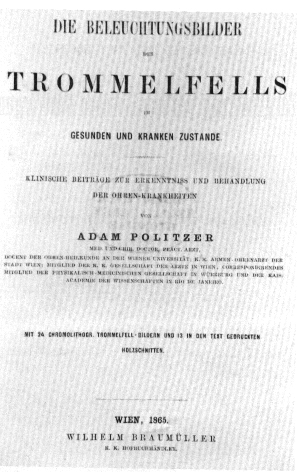
FIG. 2. Atlas of the
membrana tympani.
In 1873, Politzer designed and published 10 anatomic illustrations under the title of Zehn Wandtafeln zur Anatomie des Gehörorgans (20) (Ten tables of the anatomy of the ear). These anatomic drawings of the ear very quickly found their way onto the walls of most of the centers specializing in otology. They were also used as a teaching foundation by many otologists (21). Again, this was a completely new approach to studying the anatomy of the ear. The students were used to dealing with molds and the small drawings found in the otologic books of this era. For the first time, the drawings were big enough to be studied and explained by a teacher for all students. In this way, the quality of teaching could be perfected.

FIG. 3. Textbook of the diseases
of the ear, first edition
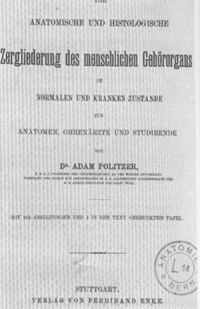
FIG. 4. The anatomic and
histologic
dissection of the ear.

FIG. 5. History of otology, volume 1.
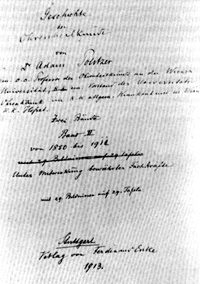
Politzer\'s hand. (Courtesy of the Institut für
Geschichte der Medizin, Vienna.)
POLITZER\'S CONTRIBUTION TO OTOLOGY

FIG. 7. Politzer\'s acoumeter.
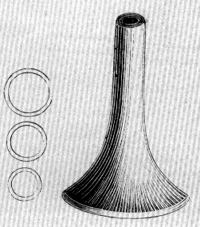
FIG. 8. Politzer\'s speculum.
Politzer studied and developed all fields relating to the ear. His scientific works were based on research along anatomic and physiologic lines. He believed that auditory testing was very important for the diagnosis of diseases related to hearing loss, because it allowed the degree of hearing alteration to be determined as well as the localization of the lesion within the ear. He distinguished between tests of bone conduction and air conduction. In 1877, he perfected an acoumeter designed to replace the watch in the measurement of hearing (80). This small portable instrument, which he held between finger and thumb, consisted of a small hammer that hit a hollow rod, producing a click of the same caliber as the ticking of a watch but more intense (Fig. 7). It allowed for the perception of sound intensity by both air conduction and bone conduction routes by placement either on the mastoid bone or at the entrance of the external auditory canal. The evaluation of the level of hearing by air conduction was achieved by measuring the distance at which the subject could hear the sound emitted. This was done independently for each ear. Politzer also tested the perception of whispered speech in each ear by repeating different words into the subject\'s ear without the aid of lip reading.
On a clinical level, he also developed a conical speculum for the external inspection of the ear, which he presented in 1862 (81). This model was slightly improved in 1878, essentially by the use of rubber in its composition (22,82) (Fig 8).
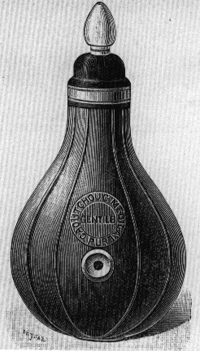
FIG. 9. Hand-held air baÄ for "politzerization."

FIG. 10. "Politzerization" method.
Politzer was also a great anatomic pathologist of the ear and thus was often the first to describe numerous pathologic conditions, for example, otosclerosis, secretory otitis media, labyrinthitis, congenital deafness, intracranial complications of otitis, and atelectasis of the ear (96). In 1893, he demonstrated that dry sclerotic middle ear catarrh was caused not by an illness of the mucous membrane of the middle ear but by a primary illness of the otic capsule (Fig. 14). This was the first description of otosclerosis (97-102). After having been discussed at length by certain of his colleagues, this theory progressively replaced the others. Politzer also participated in many diverse discussions on the origins of cholesteatoma.
|
|
|
|
|
|
POLITZER\'S PLACE IN THE HISTORY OF OTOLOGY AS AN OTOLOGIST
AND HISTORIAN
Otology as a medical specialty began progressively (103). The first truly modern developments are without doubt due to Adam Politzer (104), who elevated otology to the rank of a medical specialty. In 46 years, he transformed otology from a sterile discipline without hope into an academic discipline recognized as a specialty (105,106). Politzer was an obstinate and untiring worker, putting his teaching and his clinic first and regularly proposing his ideas to his associates, encouraging their use without being directive and using the results to develop an original and often brilliant synthesis. Despite opposition from and inertia of the colleagues who contested his ideas, he gave his nobility to otology.
Otologists worldwide owe a great debt to Politzer. He received over 7,000 foreign doctors in his clinic, always with perfect hospitality; many of these doctors were the great otologists of the era. He was able to teach with the same panache in German, English, French, Italian, Spanish, and Hungarian, all of which he spoke fluently. Well loved by his colleagues and his assistants, he often received tokens of friendship and respect (107-109). His most famous students and successors were Robert Barany, who received the Nobel Prize for medicine in 1914 for his research into vestibular physiology; Hein-rich Neumann; Gustav Alexander; and Eric Ruttin (110).
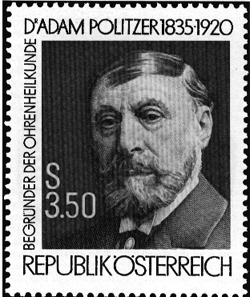
FIG. 15 Commemorative stamp of
Adam Politzer on the 150th
year of his birth.
In his honor, his name is associated with the International Society of Otology, founded in 1978. Most of the founding members had participated at the first International symposium on middle ear surgery at the Gummersbach City Hospital in Holland in 1971. The success of this first congress motivated the organizers to put in place a structure to improve the scientific program of subsequent congresses. The Politzer Society was born (111). Politzer has the right to a place in the history of otology not only as a practitioner but also as a historian. His History of otology is the most complete work that exists on this subject to date, and it is used as a source of reference by all doctors and historians who are interested in the history of otology. Politzer offered one of the greatest gifts to otology when he left to posterity all of his writings (64). His two places as otologist and historian are in perfect harmony, as Goethe put it so well, "The history of a science is the science itself." in 1985, Austria released a commemorative stamp (Fig. 15) bearing his likeness for the anniversary of his 150th birthday, seen as a supreme recognition of his work as a doctor and otologist (112). Few other otologists had the right to this honor except for two winners of the Nobel Prize for medicine, which was given to two researchers of the inner ear, Robert Barany in 1914 and Georg von Bekesy in 1961.
Much still remains to be written about Adam Politzer. However, it can be said without contest that he was probably the greatest otologist of the 19th century (8,96,113-120). He covered all spheres of otology from clinical otoscopy and hearing examinations to the development of new therapeutic procedures, including histologic examination of the ear and the description of numerous pathologic conditions. He was also a great compiler and collector of otologic knowledge of the era, often at the crossroads of different schools, mainly German, English, and French. It is still very interesting to read his works, because he presents numerous ideas that have still not been developed by modern medicine.
In 1920, a few months before his death, during the 25th anniversary of the Austrian Society of Otology, Politzer declared, "it is the duty of all who have at heart the advance of science, to look undismayed into the future and with all the forces to assume the uninterrupted work. Upon you, my younger colleagues, does this duty rest. It requires now, more than ever, devotion, industry, and perseverance. You are confronted with more difficult tasks than we, your elders, had in former days (though not wholly without struggles), when it was granted us in quiet times to consecrate ourselves to scientific pursuits."(121) the name Politzer is and will remain immortal in the history of otology.
REFERENCES
1. Durai A, Hidvegi J. in memoriam Adam Politzer. Ther Hııng 1987;35:45-7.
2. Lesky E. Die Wiener medizinische Schule im 19. Graz-Köln: Jahrhundert, 1965.
3. Politzer A. Beitrage zur Physiologie deÅ Gehörorgans. Sitzungs-berichte des Kais. Akademie der Wiessenschaften in Wien 1861: 427-38.
4. Majer EH. Zur Geschichte der HNO-Heilkunde in Osterreich. Laryng Rhinol 1980;59:406-11.
5. Stool SE, Kemper BI, Kemper MJ. The Adam Politzer and Joseph Hyrtl otologic collections at the Mütter Museum. Trans Stud Coll Physicians Phila 1972;40:92-102.
6. Stool SE, Kemper MJ, Kemper B. Adam Politzer, otology and the centennial exhibition of 1876. Laryngoscope 1975;85(11 Pt 1): 1898-904.
7. Podolski E. Adam Politzer, fırst scientific otologist. Eye Ear Nose Throat J 1956:35:581-2.
8. Lederer F. A tribute to Adam Politzer. Arch Otolaryngol 1961; 74:130-133
9. Alexander G. Adam Politzer. Wien Klin Wochenschr 1907;20: 1260-2.
10. John W. Adam Politzer. Personalbibliographien von Professoren und Dozenten der Physiologie, Psychiatrie und Ohrenheilkunde an der Medizinischen Fakultât der Universitât Wien im unge-fahren Zeitraum von 1790-1878 [dissertation]. Friedrich-Alexander-Universitat, Erlangen-Nürnberg, 1971:204-24.
11. Politzer A. Die Beleuchtungsbilder deÅ Trommelfells im gesunden und kronken Zustande. Wien: Braumüller, 1865.
12. Politzer A. Atlas der Beleuchtungsbilder deÅ Trommelfells im gesunden und kranken Zustande. Wien: Braumüller, 1896.
13. Pagenstecher A. Besprechungen: Politzer A. Die Beleuchtungsbilder des Trommelfells im gesunden und kranken Zustande. Arch Ohrenheil 1867;2:52-7.
14. Blau L. Besprechungen: Politzer A. Atlas der Beleuchtigungs-bilder des Trommelfells im gesunden und kranken Zustande für praktische Ârzte und Studirende. Arch Ohrenheil 1896;41:135-6.
15. Alt F. Kritiken: Politzer A. Atlas der Beleuchtungsbilder deÅ Trommelfells im gesunden und kranken Zustande, für praktische Aerzte und Studirende. Monatsschr Ohrenheil 1896;30:369-71.
16. Hartmann A. Besprechungen: Politzer A. Atlas der Beleuchtungsbilder deÅ Trommelfells im gesunden und kranken Zustande, für praktische Aerzte und Studirende. Zeitschr Ohrenheil 1896;29: 187-8.
17. Hirschfeld GL. Bibliographie: Politzer A. Atlas deÅ images tym-paniques â I\'etat normal et â l\'etat pathologique. Ann Mal Oreille Larynx 1896;22:331-3.
18. Griner G. Bibliographie: Politzer A. Atlas deÅ images tympa-niques â l\'etat normal et â l\'etat pathologique. Arch Int Laryngol Otol 1897;10:739^2.
19. Gradenigo G. Bibliographia: Politzer A. Atlas der Beleuchtungsbilder des Trommelfells im gesunden und kranken Zustande. Arch hal Otol 1896;4:535-6.
20. Politzer A. Zehn Wandtafeln zur Anatomie deÅ Gehörorgans. Wien: Braumüller, 1873.
21. Zaufal E. Besprechungen: Politzer A. Zehn Wandtafeln zur Anatomie des Gehörorgans. Arch Ohrenheil 1874;8:108-10.
22. Politzer A. Lehrbuch der Ohrenheilkunde für praktische Ârzte und Studierende. Stuttgart: Enke, 1878 Band I, 1882 Band II.
23. Politzer A. Lehrbuch der Ohrenheilkunde für praktische Ârzte und Studierende, 5th ed. Stuttgart: Enke, 1908.
24. Loewe L. Besprechungen: Politzer A. Lehrbuch der Ohrenheilkunde, ist ed. Band I. Arch Ohrenheil 1879;14:141.
25. Gruber J. Besprechung: Politzer A. Lehrbuch der Ohrenheilkunde, ist ed. Band I. Monatsschr Ohrenheil 1878;12:146-8, 1879;13:14-6.
26. Bezold F. Besprechungen: Politzer A. Lehrbuch der Ohrenheilkunde, ist ed. Band II. Arch Ohrenheil 1883;19:159-70.
27. Hartmann A. Besprechungen: Politzer A. Lehrbuch der Ohrenheilkunde, ist ed. Band II. Zeitschr Ohrenheil 1883;12:89-92.
28. Danjoy. Analyses: Politzer A. Traite pratique deÅ maladies de l\'oreille. Traduit par Joly A, 1883. Ann Mal Oreille Larym 1884; 10:380-90.
29. Habermann J. Besprechungen: Politzer A. Lehrbuch der Ohrenheilkunde, 2th ed. Arch Ohrenheil 1887;25:273-7.
30. Barth A. Besprechungen: Politzer A. Lehrbuch der Ohrenheilkunde, 2nd ed. Zeitschr Ohrenheil 1888;l8:9l-6.
31. Joly A. Bibliographie: Politzer A. Traite deÅ maladies de l\'oreille, 2nd ed. Ann Mal Oreille Larym. 1887; 13:370-3.
32. Blau L. Besprechungen: Politzer A. Lehrbuch der Ohrenheilkunde für praktische Aerzte und Studirende, 3rd ed. Arch Ohrenheil 1893;35:312.
33. Barth A. Besprechung: Politzer A. Lehrbuch der Ohrenheilkunde, 3rd ed. Zeitschr Ohrenheil 1893;24:248.
34. Joly A. Bibliographie: Politzer A. Lehrbuch der Ohrenheilkunde, 3rd ed. Ann Mal Oreille Larym 1893:19:350-1.
35. Grant D. Politzer A. Textbook of the diseases of the ear and adjacent organs: for students and practitioners. Dodd O, trans. J Laryngol Otol 1894;8:692-6.
36. Bruehl G. Besprechungen: Politzer A. Lehrbuch der Ohren-heilunde für praktische Aerzte und Studirende, 4th ed. Arch Ohrenheil 1901;52:283-284
37. Kirchner W. Kritiken: Politzer A. Lehrbuch der Ohrenheilkunde für practische Aerzte und Studirende, 4th ed. Monatsschr Ohrenheil 1902;36:143-9.
38. Kirchner H. Besprechungen: Politzer A. Lehrbuch der Ohrenheilkunde, 4th ed. Zeitschr Ohrenheil 1902;40:106-10.
39. Lermoyez M. Bibliographie: Politzer A. Lehrbuch der Ohrenheilkunde für praktische Aerzte und Studirende, 4th ed. Ann Mal Oreille Larym 1902;28:140-2.
40. Grant D. Review: Politzer A. A text-book of the diseases of the ear and adjacent organs: for students and practitioners, 4th ed. Trans. J Laryngol Otol 1903;18:335-6.
41. Gradenigo G. Bibliographia: Politzer A. Lehrbuch der Ohrenheilkunde, 4th ed. Arch hal Otol 1901;! 1:378-80.
42. Alt F. Besprechungen: Politzer A. Lehrbuch der Ohrenheilkunde für praktische Ârzte und Studirende, 5th ed. Arch Ohrenheil 1908:78:150-2.
43. Frey H. Kritiken: Politzer A. Lehrbuch der Ohrenheilkunde, 5th ed. Monatsschr Ohrenheil 1908;42:519-20.
44. Bruehl G. Besprechungen: Politzer A. Lehrbuch der Ohrenheilkunde, 5th ed. Zeitschr Ohrenheil 1908;56:416-7.
45. Lermoyez M. Bibliographie: Politzer A. Lehrbuch der Ohrenheilkunde für praktische Aerzte und Studierende, 5th ed. Ann Mal Oreille Larym. 1908;34:104-5.
46. Grant D. Review: Politzer A. Lehrbuch der Ohrenheilkunde für praktische Aerzte und Studierende, 5th ed. J Laryngol Otol 1909; 24:53-6.
47. Gradenigo G. Bibliographia: Politzer A. Lehrbuch der Ohrenheilkunde, 5th ed. Arch Ital Otol 1912;23:349-50.
48. Politzer A. Die anatomische und histologische Zergliederung deÅ menschlichen Gehörorgans. Stuttgart: Enke, 1889.
49. Morpurgo E. Besprechungen: Politzer A. Die anatomische und histologische Zergliederung deÅ menschlichen Gehörorgans im normalen und kranken Zustande. Arch Ohrenheil 1889;28:297-9.
50. Moos S. Besprechungen: Politzer A. Die anatomische und histologische Zergliederung des menschlichen Gehörorgans. Zeitschr Ohrenheil 1890;20:87-90.
51. Hirschfeld GL. Bibliographie: Politzer A. Die anatomische und histologische Zergliederung deÅ menschlichen Gehörorgans im normalen und kranken Zustande für Anatomen, Ohrenarzte und Studenten. Ann Mal Oreille Larynx 1889;15:342-8.
52. Lombard E. Bibliographie: Politzer A. La dissection anatomique et histologique de l\'organe auditif de l\'homme â l\'etat normal et pathologique. Schiffers F, trad. française, 1897. Ann Mal Oreille Larynx 1898;24:426-32.
53. Grant D. Revievv: Politzer A. The anatomic and histologic dissection of the human ear in the normal and diseased condition. Stone G, trans. J Laryngol Otol 1892;6:144-6.
54. Mounier F. Bibliographie: Politzer A. La dissection anatomique et histologique de l\'organe auditif de 1\'homme â l\'etat normal et pathologique, â l\'usage deÅ anatomistes, deÅ medecins auristes et deÅ etudiants. Schiffers F, trad. française, 1898. Arch ini Laryngol Otol 1897:10:742-1.
55. Politzer A. Geschichte der Ohrenheilkunde. Stuttgart: Enke, 1907 Band I, 1913 Band II.
56. Politzer A. History of otology. Vol 1. Millstein S, Portnoff C, Coleman A, trans. Phoenix: Columella, 1981.
57. Schwartze H. Besprechungen: Politzer A. Geschichte der Ohrenheilkunde. Band I. Arch Ohrenheil 1907;71:126-30.
58. Frey H. Kritiken: Politzer A. Geschichte der Ohrenheilkunde. Band I. Monatsschr Ohrenheil 1907;41:291-2.
59. Bruehl G. Besprechungen: Politzer A. Geschichte der Ohrenheilkunde. Band I. Zeitschr Ohrenheil 1907;54:91-3.
60. Lermoyez M. Bibliographie: Politzer A. Geschichte der Ohrenheilkunde. Band I. Ann Mal Oreille Larynx 1907;33:418-37.
61. Grant D. Review: Politzer A. Geschichte der Ohrenheilkunde. Band 1. J Laryngol Otol 1907;22:477-80.
62. Gradenigo G. Bibliographia: Politzer A. Geschichte der Ohrenheilkunde. Band I. Arch Ital Otol 1907;18:188-91.
63. Neuburger M. Besprechungen: Politzer A. Geschichte der Ohrenheilkunde. Band II von 1850-1911. Arch Ohrenheil 1913;92: 149-57.
64. Frey H. Bücherbesprechungen: Politzer A. Geschichte der Ohrenheilkunde. Band II. Monatsschr Ohrenheil 1914;48:66-7.
65. Korner O. Bücherbesprechungen: Politzer A. Geschichte der Ohrenheilkunde. Band II. Zeitschr Ohrenheil 1914;70:136-7.
66. Lermoyez M. Bibliographie: Politzer A. Histoire de l\'otologie. Seconde partie de 1850 â 1911. Ann Mal Oreille Larynx 1913; 39:84-5.
67. Bibliographie. Politzer A. Histoire deÅ maladies de l\'oreille (Geschichte der Ohrenheilkunde), 1913 Band II. Rev Hebd Laryngol Otol 1913;34:288-91.
68. Bruehl G, Politzer A. Atlas und Grundriss der Ohrenheilkunde. Muenchen: Lehmann, 1901.
69. Eschweiler. Besprechungen: Brühl G, Politzer A. Atlas und Grundriss der Ohrenheilkunde. Arch Ohrenheil 1901;52:285.
70. Hartmann A. Besprechungen: Brühl G, Politzer A. Atlas und Grundriss der Ohrenheilkunde. Zeitschr Ohrenheil 1901;39: 295-6.
71. Lombard E. Bibliographie: Brühl G, Politzer A. Atlas et precis d\'otologie. Ann Mal Oreille Larynx 1901;27:394.
72. Lermoyez M. Bibliographie: Brühl G, Politzer A. Atlas manuel deÅ maladies de l\'oreille. Ed. française Laurens G, 1902. Ann Mal Oreille Larym 1903;29:384-6.
73. Grant D. Review: Brühl G, Politzer A. Atlas and epitome of otology. Trans. ist ed. J Laryngol Otol 1903;18:560.
74. Fröse. Besprechungen: Brühl G, Politzer A. Grundriss und Atlas der Ohrenheilkunde. Arch Ohrenheil 1905;66:296-7.
75. Urbantschitsch V. Kritiken: Brühl G, Politzer A. Grundriss und Atlas der Ohrenheilkunde, 2nd ed. Monatsschr Ohrenheil 1905; 39:490-1.
76. Hartmann A. Besprechungen: Brühl G, Politzer A. Grundriss und Atlas der Ohrenheilkunde. Zeitschr Ohrenheil 1906;51:339.
77. Gradenigo G. Bibliographia: Brühl G, Politzer A. Grundriss und Atlas der Ohrenheilkunde. Arch Ital Otol 1906;17:175-6.
78. Alexander G. Besprechungen: Brühl G, Politzer A. Lehrbuch und Atlas der Ohrenheilkunde, 3rd ed., 1913. Arch Ohrenheil 1913; 92:157-8.
79. Stenger. Bücherbesprechungen: Brühl G, Politzer A. Lehrbuch und Atlas der Ohrenheilkunde, 3rd ed. Zeitschr Ohrenheil 1913; 69:94.
80. Politzer A. Ueber einen einheitlichen Hörmesser. Arch Ohrenheil 1877;12:104-9.
81. Politzer A. Uber Okularinspektion deÅ Trommelfells. Wien V/ochenbl 1862;28:189-91.
82. Feldmann H. Die Geschichte der Ohr-Specula. Laryngol-Rhino-Otol 1996;75:311-8.
83. Stangerup SE. Autoinflation: historical highlights and clinical im-plications. Ear Nose Throat J 1998;77:737-42.
84. Politzer A. Ueber ein neues Heilverfahren gegen Schwer-hörigkeit, infolge von Unvvegsamkeit der Eustachischen Ohr-trompete. Wien Med Wochenschr 1863;6:83-90,102-4.
85. von Troeltsch A. Politzer\'sche Verfahren zur Wegsammlung der Ohrtrompete. Arch Ohrenheil 1864;l:28-43.
86. Brühl G. Nachruf Adam Politzer. Arch Ohrenheil 1920;106:i-v.
87. Hofmann L. Über den Vorlaufer deÅ Politzer\'schen Verfahren im Altertum und Mittelalter. Monatsschr Ohrenheil 1959;93:330-6.
88. Politzer A. Ueber zwei angeblich neue Verfahren zur Wegsam-machung der Ohrtrompete. Wien Med Wochenschr 1875;47: 1017-20,49:1073-5.
89. Zaufal E. Wissenschafliche Rundschau: Politzer A. Ueber zwei angebliche neue Verfahren zur Wegsammachung der Ohrtrompete. Arch Ohrenheil 1876;! 1:173-6.
90. Politzer A. Ueber die Anwendung deÅ Paukenröhrchens. Wien Med Wochenschr 1873;9:196-9, 10:220-2, 11:241^; 1875;15: 289-91, 16;308-12.
91. Trautmann LF. Wissenschaftliche Rundschau. Politzer A. Ueber die Anwendung deÅ Paukenröhrchens. Arch Ohrenheil 1876;! l: 69-72.
92. Politzer A. Ein kleines Instrument für Schwerhörige. Wien Med Wochenschr 1881;! 8:505-8.
93. Jacobi L. Wissenschaftliche Rundschau. Politzer A. Ein kleines Instrument für Schwerhörige. Arch Ohrenheil 1881;17:300.
94. Politzer A. Ein neues kleines Hörinstrument für Schwerhörige. Wien Med Wochenschr 1884;22:679-83.
95. Bürkner K. Wissenschaftliche Rundschau. Politzer A. Ein neues kleines Hörinstrument für Schwerhörige. Arch Ohrenheil 1885; 22:161.
96. Weir N. Adam Politzer\'s influence on the development of inter-national otology. J Laryngol Otol 1996; 110:823-9.
97. Politzer A. Ueber primare Erkrankung der knöchernen Labyrinth-kapsel. Zeitschr Ohrenheil 1893;25:309-27.
98. Politzer A. On a primary affection of the labyrinthine capsule. J Laryngol Otol 1894;8:286-8.
99. Politzer A. Sull\' affezione primitiva della capsula labirintica come causa di sordita progressiva. Arch Ital Otol 1894;2:295-7.
100. Politzer A. On a peculiar affection of the labyrinthine capsule as a frequent cause of deafness. Transactions ist Panamerican Medical Congress 1895:1607-8.
101. Blau L. Wissenschaftliche Rundschau. Politzer A. Ueber primare Erkrankung der knöchernen Labyrinthkapsel. Arch Ohrenheil 1895;39:82-3.
102. Adam Politzer (1835-1920), otolaryngologist [editorial. JAMA 1969;207:1908.
103. Mudry A. A history of otology through the development of sci-entifıc and medical thought. Açta Otorhinolaryngol Belg 1998; 52:257-70.
104. Neumann H. Politzer Adam (1835-1920). Wien Klin Vfochenschr 1920;35:767-8.
105. Majer EH. Adam Politzer. C Un Otolaryngol 1978;3:229-32.
106. Majer EH. Adam Politzer (1835-1920). Laryngol Rhinol 1978; 57:769-72.
107. Collet FJ. Souvenirs d\'un printemps viennois. Ann Oto-Laryngol (Paris) 1957;74:1000-9.
108. Stool SE. A historical vignette: memoirs of an otologist\'s European study in 1883. Am J Otol 1983;4:346-9.
109. Rauge P. La clinique Politzer. Arch Int Laryngol Otol 1896;9: 492-501.
110. Shapiro SL. Adam Politzer and his pupils. Eye Ear Nose Throat J 1969;48:306-9.
111. Jansen C. The Politzer Society: a short historical revievv. Ear Nose Throat J 1996;75:3^
112. Haas LF. Neurological stamp: Adam Politzer (1835-1920). J Neurol Neurosurg Psychiatry 1999;66:535.
113. Gomperz B. Trauerfeier für Weiland Hofrat Politzer. Monatsschr Ohrenheil 1921;55:57-71.
114. Siebenmann F. Adam Politzer 1835-1920. Zeitschr Ohrenheil 1920;80:314-8.
115. Urbantschitsch V. Hofrat Professor Dr. Adam Politzer. Monatsschr Ohrenheil 1920;54:769-71.
116. Ballester L, Olagüe G, Ciges M. Classics in modern otology. Granada: University Press, 1978.
117. Majer EH, Skopec M. History of oto-rhino-laryngology in Aus-tria. Wien: Brandstâtter, 1985.
118. Mounier-Kuhn P, Guerrier Y. Histoire deÅ maladies de l\'oreille, du nez et de la gorge. Paris: Dacosta, 1980.
119. Sultan A. Histoire de l\'otologie. Dans: Naissance et developpe-ment de l\'oto-rhino-laryngologie dans l\'histoire de la medecine. Açta Otorhinolaryngol (Belg) 1981;55(suppl IV):1141-398.
120. Weir N. Otolaryngology: an illustrated history. Cambridge: Butterworths, 1990.
121. Politzer A. Rückblick auf die 25 jahrige Tatigkeit der Osterre-ichischen otologischen Gesellschaft. Wien Med Wochenschr 1920;22:985-90.